Related Research Articles

The San Diego Zoo Safari Park, originally named the San Diego Wild Animal Park until 2010, is an 1,800 acre zoo in the San Pasqual Valley area of San Diego, California, near Escondido. It is one of the largest tourist attractions in San Diego County. The park houses a large array of wild and endangered animals including species from the continents of Africa, Asia, Europe, North and South America, and Australia. This includes the largest collection of hoofed mammals in the world. The park is in a semi-arid environment, and one of its most notable features is the Africa Tram, which explores the expansive African exhibits. These free-range enclosures house such animals as antelopes, giraffes, buffalo, cranes, and rhinoceros. The park is also noted for its California condor breeding program.

Whipsnade Zoo, formerly known as ZSL Whipsnade Zoo and Whipsnade Wild Animal Park, is a zoo and safari park located at Whipsnade, near Dunstable in Bedfordshire, England. It is one of two zoos that are owned by the Zoological Society of London (ZSL), a charity devoted to the worldwide conservation of animals and their habitats.

The African buffalo is a large sub-Saharan African bovine. There are five subspecies that are recognized as being valid. Syncerus caffer caffer, the Cape buffalo, is the nominotypical subspecies, and the largest one, found in Southern and East Africa. S. c. nanus is the smallest subspecies, common in forest areas of Central and West Africa, while S. c. brachyceros is in West Africa and S. c. aequinoctialis is in the savannas of East Africa. The adult African buffalo's horns are its characteristic feature: they have fused bases, forming a continuous bone shield across the top of the head referred to as a "boss".
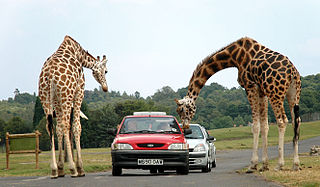
West Midland Safari and Leisure Park is a safari park located in Bewdley in Worcestershire, England. It was opened under the name of West Midland Safari Park in Spring 1973.
Port Lympne Hotel & Reserve near the town of Hythe in Kent, England is set in 600 acres (2.4 km2) and incorporates the historic Port Lympne Mansion, and landscaped gardens designed by architect Sir Herbert Baker, for Sir Philip Sassoon.

Knowsley Safari is a safari park and tourist attraction near Prescot, England. It is a member of the British and Irish Association of Zoos and Aquariums (BIAZA) and the European Association of Zoos and Aquaria (EAZA). It contributes to conservation and research through links with conservation projects and its links with universities in nearby Liverpool, as well as Chester and Manchester.

Hatari! is a 1962 American adventure romantic comedy film starring John Wayne as the leader of a group of professional game catchers in Africa. Directed by Howard Hawks, it was shot in Technicolor and filmed on location in northern Tanganyika. The film includes dramatic wildlife chases and the scenic backdrop of Mount Meru, a dormant volcano.
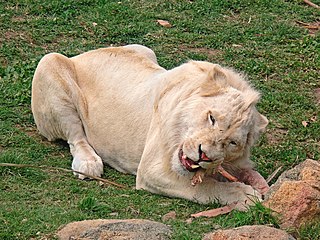
The white lion is a rare colour mutation of the lion, specifically the Southern African lion. White lions in the area of Timbavati are thought to have been indigenous to the Timbavati region of South Africa for centuries, although the earliest recorded sighting in this region was in 1938. White lions first became known to the English-speaking world in 1977 through the book The White Lions of Timbavati.
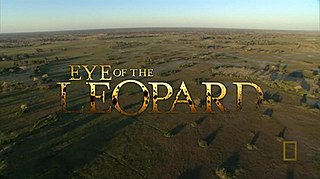
Eye of the Leopard is a 2006 National Geographic documentary directed by Dereck and Beverly Joubert. Set in the Mombo region of the Okavango Delta, Botswana, the film explores the life of a female leopard, Legadema, as she matures from a cub to an adult. Jeremy Irons, voice actor of Scar from Disney's 1994 animation The Lion King, narrates the film. It premiered in the US on the National Geographic Channel on October 8, 2006, and has won many awards including the BBC wildscreen Panda award for Best Sound Wild Screen and an Emmy. Since the success of the film, a book and an app of the same title have been released.

The wildlife of Zimbabwe occurs foremost in remote or rugged terrain, in national parks and private wildlife ranches, in miombo woodlands and thorny acacia or kopje. The prominent wild fauna includes African buffalo, African bush elephant, black rhinoceros, southern giraffe, African leopard, lion, plains zebra, and several antelope species.
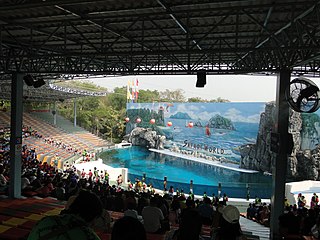
Safari World is a tourist attraction in Bangkok, Thailand that consists of two parks named Marine Park and Safari Park, operated by Safari World Public Limited. The park was opened in 1988 with a total area of 480 acres (190 ha) for its open zoo and 180 acres (73 ha) for its bird park. A major renovation to enhance effectiveness of land use began on 17 April 1989 and its total area developed for the leisure park now consists of an open zoo and a marine park on 500 rai of land.
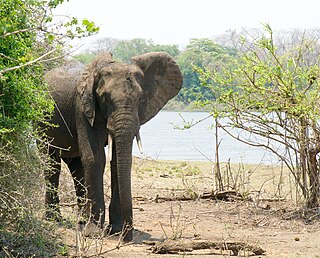
Majete Wildlife Reserve is a nature reserve in southwestern Malawi, established as a protected area in 1955. The reserve's animal populations were decimated during the late 1970s and 1980s due to poaching and other human activities. Majete has been managed by African Parks since 2003, when the nonprofit conservation organization entered into a public–private partnership with the Malawi Department of National Parks and Wildlife (DNPW). Since then, wildlife has been restored, the park has achieved big five game status, and tourism has increased.

Balule Nature Reserve is a protected area in Limpopo Province, South Africa which forms part of the Greater Kruger National Park as a member of the Associated Private Nature Reserves (APNR). As part of a wildlife conservation initiative, all fences separating APNR reserves – Balule, Timbavati, Klaserie, Umbabat, – and the Kruger National Park have been removed.
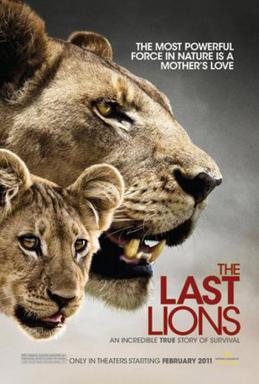
The Last Lions is a 2011 African nature documentary film by National Geographic Society, videotaped and directed by Dereck and Beverly Joubert. It was shot in Botswana's Okavango Delta. The film premiered at the Palm Springs International Film Festival in January 2011 and was released in select theaters the following month on February 18. The film follows in the tradition of other National Geographic big cat films, such as India: Land of the Tiger and Eye of the Leopard.
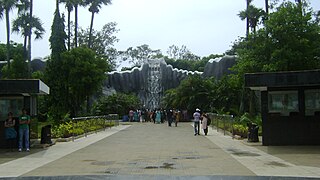
Arignar Anna Zoological Park, also known as the Vandalur Zoo, is a zoological garden located in Vandalur, to southwest of Chennai, Tamil Nadu, about 31 kilometres (19 mi) from the Chennai Central and 15 kilometres (9.3 mi) from Chennai Airport. Established in 1855, it is the first public zoo in India. It is affiliated with the Central Zoo Authority of India. Spread over an area of 602 hectares, including a 92.45-hectare (228.4-acre) rescue and rehabilitation centre, the park is the largest zoological park in India. The zoo houses 2,553 species of flora and fauna across 1,265 acres (512 ha). As of 2012 the park houses around 1,500 wild species, including 46 endangered species, in its 160 enclosures. As of 2010, there were about 47 species of mammals, 63 species of birds, 31 species of reptiles, 5 species of amphibians, 28 species of fishes, and 10 species of insects in the park. The park, with an objective to be a repository of the state's fauna, is credited with being the second wildlife sanctuary in Tamil Nadu after Mudumalai National Park.

Marloth Park is a holiday town situated in northeastern South Africa in the Mpumalanga province.

Great Plains Conservation is conservation and tourism organization, it helps manage several wildlife reserves in Kenya, Botswana and Zimbabwe. The group currently operates 18 safari camps, which include luxury lodges and tented camps. Great Plains Conservation works together with local governments and community groups to promote low-density, environmentally conscious tourism, supplying economic incentives for the protection of wildlife.

The SanWild Wildlife Sanctuary is a 5,000 ha (50 km2) wildlife rehabilitation center and reserve in South Africa's Limpopo Province, located a few kilometers south of Leydsdorp, and near the western boundary of the Kruger National Park.
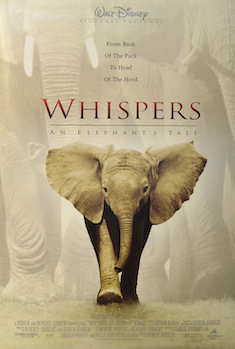
Whispers: An Elephant's Tale is a 2000 American adventure film co-written, co-produced and directed by Dereck Joubert and featuring the voice work of Angela Bassett, Joanna Lumley, Anne Archer, Debi Derryberry and Kevin Michael Richardson.
Dereck Joubert is a South African-born filmmaker, author, conservationist and National Geographic explorer-in-residence based in Botswana. He is also the brother of well known South African artist and conservationist Keith Joubert.
References
- 1 2 3 Watts, Frank. "Battle in the Kruger". Nhongo Safaris.co.za. Archived from the original on 21 August 2016. Retrieved 22 July 2015.
- ↑ "Battle at Kruger". YouTube. 3 May 2007. Archived from the original on 21 December 2021. Retrieved 26 February 2014.
- ↑ "2nd Annual YouTube Awards Winners". YouTube. Retrieved 4 April 2008.
- ↑ "A little help from his friends". Time . Vol. 169, no. 26. 25 June 2007. p. 47.
- ↑ Millhon, Drew (1 August 2007). "Video Captures Animal Battle for Survival". ABC News Internet Ventures. Archived from the original on 13 August 2016. Retrieved 8 August 2007.
- ↑ "You've Seen the YouTube Video; Now Try the Documentary". The New York Times . 10 May 2008.
A Canon ZR50MC MiniDV
- ↑ Johnson, Bobbie (10 August 2007). "10m viewers for YouTube phenomenon". The Guardian . Retrieved 18 September 2007.
- ↑ "Sue McDonnell PhD (Profile)". University of Pennsylvania . Archived from the original on 10 December 2007. Retrieved 18 September 2007.
- ↑ Kluger, Jeffrey (7 June 2007). "When Animals Attack — and Defend". Time. Archived from the original on 10 June 2007. Retrieved 18 September 2007.
- ↑ "Dereck Joubert Biography (1956-)". filmreference.com. Retrieved 18 September 2007.
- ↑ Millhon, Drew (1 August 2007). "Video Captures Animal Battle for Survival". ABC News. Archived from the original on 12 August 2016. Retrieved 14 July 2008.